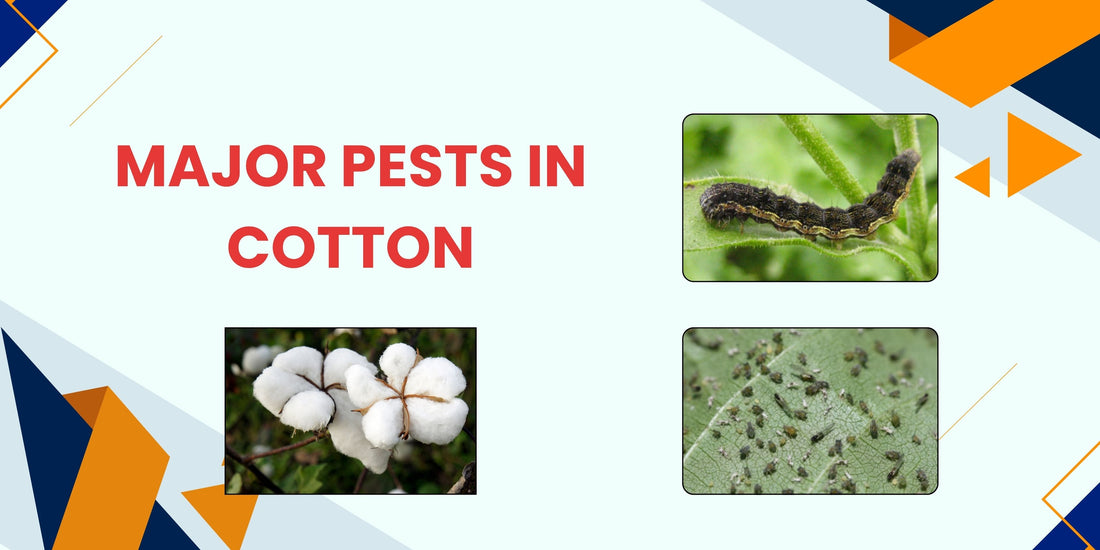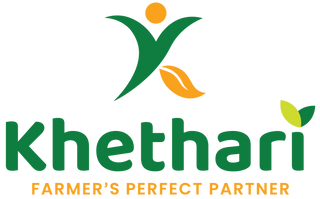
MAJOR PESTS IN COTTON
Introduction:
Cotton is one of the most important cash crop,worldwide. It plays a major role in supplying rawmaterial to textile industry. It is an important source of livelihood for many farmers. Cotton is cultivated on a large scale in India and also in Telangana. The crop is susceptible to wide range of pests which is a major challenge for its production and profitability. So,it is important to understand and control these pests. This article will give details on major pests affecting cotton crop and proper management practices to control them.
List of pests in Cotton:
- Pink bollworm
- Spotted bollworm
- American bollworm
- Tobacco caterpillar
- Aphids
- Thrips
- Whitefly
- Jassids
- Cotton stem weevil
- Red cotton bug
- Mealy cotton bug.
Major pests:
1. Pink bollworm:
Scientific name: Pectinophors gossypiella
Symptoms:
- Rosetted flowers
- The holes of entry plugged by excreta of larvae which are feeding inside the seed kernels.
- They cut window holes (interlocular burrowing) in the two adjoining seeds thereby forming "double seeds"
- The attacked buds and immature bolls drop off.
- Discolored lint and burrowed seeds.
Management:
ETL: 10% infested fruiting parts
- Use pheromone trap to monitor the adult moth activity
-
Three weekly releases of egg parasitoid Trichogrammatoidea bactrae @ 1,00,000/ha per release
coinciding the incidence of the pest.Dust carbaryl 5%D 20 kg/ha
Spraying any one of the following insecticides:
- Phosalone 35%EC 2000 ml/ha
- Triazophos 40EC 2.5l/ha.
2. American bollworm:
Scientific Name: Helicoverpa armigera
Symptoms:
- Bolls showing regular, circular bore holes
- Larvae seen feeding on the boll by thrusting their heads alone inside and leaving the rest of the body outside
- Presence of granular faecal pellets outside the bore hole.
- A single larva can damage 30-40 bolls.
Management:
ETL: One egg or one larva /plant.
Monitoring: Pest monitoring through light traps, pheromone traps and in situ assessments by roving and fixed plot surveys has to be intensified at farm, village, block, regional and State levels. For management, an action threshold of one egg per plant or 1 larva/ plant may be adopted.
Cultural practices:
- Synchronised sowing of cotton preferably with short duration varieties in each cotton ecosystem.
- Avoid continuous cropping of cotton both during winter and summer seasons in the same area as well as ratooning.
- Avoid monocropping. Growing of less preferred crops like greengram, blackgram, soyabean, castor, sorghum etc., along with the cotton as intercrop or border crop or alternate crop to reduce the pest infestation.
- Removal and destruction of crop residues to avoid carry over of the pest to the next season, and avoiding extended period of crop growth by continuous irrigation.
- Optimising the use of nitrogenous fertilizers which will not favour mthe multiplication of the pest.
- Judicious water management for the crop to prevent excessive vegetative growth and larval harbourage.
Biological control:
-
Application of Nuclear Polyhedrosis Virus (NPV) at 3 x 10 12 POB /ha in evening hours at 7th and
12th week after sowing. - Conservation and augmentation of natural predators and parasitoids for effective control of the pest.
- Inundative release of egg parasitoid, Trichogramma spp., at 6.25 cc/ha at 15 days interval 3 times from 45 DAS
- Egg-larval parasitoid, Chelonus blackburnii and Predator Chrysoperla carnea at 1,00,000/ha at 6th, 13th and 14th week after sowing.
- ULV spray of NPV at 3 x 10 12 POB /ha with 10% cotton seed kernel extract, 10% crude sugar, 0.1% each of Tinopal and Teepol for effective control of Helicoverpa.
-
Note: Dicofol, methyl demeton, phosalone are comparatively safer to Chrysoperla larva
recording low egg mortality.
Chemical control:
- Discourage the indiscriminate use of insecticides, particularly synthetic pyrethroids.
- Use of proper insecticides which are comparatively safer to natural enemies such as endosulfan, phosalone, etc., at the correct dosage and alternating different groups of insecticides for each round of spray.
- Avoid combination of insecticides as tank mix.
- Adopt proper delivery system using spraying equipments like hand compression sprayer, knapsack sprayer and mist blower to ensure proper coverage with required quantity of spray fluid and avoid ULV applications or Akela spray applications.
- Proper mixing and preparation of spray fluid for each filling of spray fluid tank.
3. Tobacco caterpillar:
Scientific name: Spodoptera litura
Symptoms:
- Irregular holes on leaves initially and later skeletonisation leaving only veins and petioles.
- Heavy defoliation
- Presence of bored holes.
Management:
ETL: one egg mass / 10 plants
Management:
Monitoring: Install sex pheromone traps @ 2-3 traps/ac.
- Collection and destruction of the infested material from the field.
- Plucking of leaves harbouring egg masses/gregarious larvae and destroying.
- Setting up light traps for adults.
- Setting up of pheromone traps @ 12/ha
- Spraying NSKE 5% against eggs and first instar larva
- Spraying Spli NPV @ 200LE/ac in combination with jaggery 1 kg, sandovit 100 ml or Robin Blue 50 g thrice at 10-15 days interval
- Release of egg parasitoid Trichogramma @ 50,000/ha/week four times
- Poison Baiting with rice bran 10kg + jaggery 2 kg+ chlorpyriphos 750 ml or thiodicarb 300g in sufficient quantity of water in form of small balls and broadcasting in evening hours in one acre.
4. Spotted bollworm:
Scientific name: Earias vitella
Symptoms:
- Presence of wilting, withering and drooping or drying of tender shoots in early stage of crop growth.
- Presence of bored flower buds (squares), bored bolls with larval frass at the entrance holes.
- Premature dropping of affected bolls.
- Premature opening of damaged bolls, which remain on plants.
- Presence of badly damaged tissues including lint and seed in damaged bolls.
Management:
Collection and destruction of infested shoots, squares and bolls and the fallen material.
- Adopting crop rotation.
- Deep ploughing in summer
- Inter cultivation with sorghum, greengram, cluster bean, jowar etc.
- Setting of pheromone traps @ 12/ha.
- Release of Egg parasitoids like: Trichogramma evanescens and
- larval parasitoids; B. hebetor, B. brevicornis.
- Release of first instar larvae of Chrysoperla sp. @ 1,00,000/ha.
- Foliar spray with Bacillus thuringiensis @2g/l of water.
- Spray with Chloranthraniprole @ 0.3 ml/lit or Chlorpyriphos @ 2.5 ml/lit.
5. Aphids:
Scientific name: Aphis gosssypii
Symptoms:
- Infesting tender shoots and under surface of the leaves.
- Curling and crinkling of leaves
- Stunted growth
- Blighted appearance when infestation is severe
- Development of black sooty mould due to the excretion of honey dew giving the plant a dark appearance.
Management:
ETL: 10 Aphids/leaf
➤ Preventive measures:
- Seed treatment with imidacloprid 60FS @ 10g/kg seeds or thiomethoxam 35FS @ 5g/kg seeds
➤ Curative measures:
- Set up blue sticky trap @ 20/ acre.
- Foliar application of NSKE 5 per cent or Azadirachtin 1 EC @ 2ml/l.
- Spray with Acetamapride @ 0.2 g/lit or Imidacloprid @ 0.25 ml/lit or Thiometoxam @ 0.2 g/lit or Dinotefuran @ 0.3 g/lit.
- For effective control use Dr. Eliminator
Product link : https://www.khethari.com/products/dr-eliminator-insecticide?srsltid=AfmBOorGkOiakGHkwN61X6TFGFRjxfMWzWO0WYB4OH0hgpd06PcoSxyk
6. Whitefly:
Scientific name: Bemisia tabaci
Symptoms:
- Chlorotic spots on the leaves which latter coalesce forming irregular yellowing of leaf tissue which extends from veins to the outer edges of the leaves.
- Severe infestation results in premature defoliation.
- Development of sooty mould.
- Shedding of buds and bolls and poor boll opening.
- It also transmits the leaf curl virus diseases of cotton.
Management:
ETL: 5 Whiteflies /leaf
➤ Preventive measures:
- Do not use pyrethroids.
- Avoid alternate hosts in the surrounding area of cotton.
- Maintaining field sanitation.
➤ Curative measures:
- Set up yellow sticky trap @ 20/acre.
- Foliar application of NSKE 5per cent or Azadirachtin 1 EC @ 2ml/l.
- Foliar application of any one chemical.
FAQs:
1. What are the major pests of cotton?
Bollworms and Sucking pests are the major pests affecting the cotton. Bollworms include American bollworm,Spotted bollworm, and Pink bollworm.Sucking pests include Aphids,Whiteflies,Thrips,Mealybugs.
2. How bollworms are damaging the cotton crop?
They feed on cotton bolls and damages the developing seeds which reduces the quality of lint and ultimately results in reduced yields.
3. What are cultural practices for managing cotton pests?
We can follow cultural practices like crop rotation,maintaing proper spacing,timely sowing, removing infected plant debris after harvest to manage pests in cotton.
4. How do weather conditions influence pest outbreak in cotton?
Warm and humid conditions favour the infestation of pests like whiteflies and bollworms,whereas dry weather favours the infestation of jassids and thrips.
5. How do whiteflies affect cotton plants?
Whiteflies suck the sap from leaves which weakens the plants and also excretes honeydew which is responsible for the development of sootymould,reduces photosynthesis and ultimately reduces quality and yield.
Conclusion:
Controlling the major pests namely Pink bollworm,American bollworm,Spotted bollworm,Tobacco caterpillar, and sucking pests like Whiteflies,Aphids,Thrips,Jassids is important to reduce economic losses and to improve yield and quality.We should follow some effective management techniques like using resistant varieties, proper field and water management,crop rotation,balanced fertilization,preserving natural predators and avoiding alternate hosts. Along with these practices we can use biopesticide "Dr. Eliminator" for controlling Sucking pests and “LARVEX” to control bollworm infestation.By following these measures farmers can reduce losses and improve quality and productivity.
